IBM ScrollPoint Information and Software

The original ScrollPoint mouse debuted in 1998 to combine the similar TrackPoint mechanism as found on the ThinkPads to replace a standard mouse wheel. As the ScrollPoint mechanism operates on an X/Y axis it allows 360 degree scrolling (although without drivers installed it will only operate with vertical scrolling and at rather fast rates). Speed is controlled based on the pressure applied for continuous-dynamic scrolling; this reduces the strain on the finger caused by standard scroll wheels and also allows the user to adjust the speed on a variable basis (not fixed to a set interval at any given time).
As ScrollPoints offer superior functionality to the standard 'wheel' mechanism, it's very curious why this alternative design never overtook standard mice. A few reasons may be that (1) most people don't like change, (2) the ScrollPoint performs too fast without drivers, (3) IBM didn't push marketing or continue to really develop the product into the mainstream. Regardless, it does have a following of few who like the ergonomy and enhanced scrolling ability.
The concept for the 'ScrollPoint' started in 1997 at the IBM Alamden Research Center; to determine the most efficient way to scroll through documents. The research document can be read here:
--> Improving Browsing Performance (Shumin Zhai, Barton Smith, Ted Selker)
Lenovo still manufactures the standard 3-button ScrollPoint III mice. Update: 5/1/2016: Lenovo no longer manufactures any ScrollPoint mice anymore so they're now officially dead. It can only be obtained used or NOS at this point going forward. They discontinued the more elaborate ScrollPoint III Pro Model 31P8700 (as pictured above) in 2009, presumably due to the cost of manufacture and little demand. Despite IBM's original Almaden page proclaiming "After a few days with the ScrollPoint, you'll find you can't go back" most people still prefer wheels.
Software and Drivers
--> Lenovo mouse suite 6.78 (Windows XP, Vista, 7, 8, 8.1, 10)
This is the latest release from Lenovo for the driver. It works with all USB ScrollPoints and ScrollPoint Pros. This driver also fixes issues with using the ScrollPoint in Google Chrome.
---
--> ScrollPoint driver suite (Windows 2000 through Windows 7)
--> ScrollPoint driver (Linux - redirect to Github)
--> ScrollPoint driver suite (Windows 9x, Me, NT)
--> ScrollPoint driver suite (OS/2 WARP)
These drivers are for the regular ScrollPoint, with the exception of the Linux driver
---
--> ScrollPoint Pro driver suite (Windows Vista, 7)
--> ScrollPoint Pro driver suite (Windows W2K, XP)
--> ScrollPoint Pro driver suite (Windows NT, 95, 98, W2K)
These are specific ScrollPoint 'Pro' drivers which aren't meant for the other mice
ScrollPoint Common Issues
#1 "The rubber coating on my ScrollPoint is sticky and unpleasant"
The stickiness is caused when the IBM rubber compound breaks down; generally when it comes in contact with solvents or excessive humidity. If your ScrollPoint isn't new and has a damaged rubber coating, just use a magic eraser and gently remove the rubber or let the plastic soak in water and soap for a few hours and rub it off with a coarse cloth. If you're moderately gentle the original porous texture underneath the rubber will be preserved.
#2 "The teflon pads on my ScrollPoint Pro keep coming off"
This problem seems to be more specific to the ScrollPoint Pro's lower teflon pad-- especially if you removed it previously to open the mouse up. Probably some gorilla glue or any polymer glue will keep it stuck on indefinitely.
#3 "My ScrollPoint sometimes doesn't power on, stops working after awhile or doesn't respond well"
IBM's outsourced manufacturers (such as Goodwell) didn't bother to carry quality capacitors; therefore lower-end suscon or similar brands are used. Simply replace these capacitors with Rubycon YXF/YXJ series-- the values in the ScrollPoints I looked at were all 10uF. 10uF 50v capacitors will fit without touching the top of the mouse enclosure.
#4 "My ScrollPoint's cursor sometimes jumps around at random intervals / Scrolling is unreliable"
Replace the resonator, they're in a resin dipped package.
#5 "My ScrollPoint won't scroll in Google Chrome"
Google Chrome has a very poor interpreter for scroll input devices: this has been the case even when Chrome was in its beta stages. Install the latest Lenovo driver which I think makes Chrome see it as a standard wheeled device-- since that's all it has been programmed to see. Or.... switch to Fire Fox which has no issues with alternative input devices.
#6 "My ScrollPoint Pro is getting worn out and there isn't an equivalent substitute"
Unfortunately these mice are discontinued and there's no way around it. It's impossible to purchase this mouse new unless you can find new old stock. The best alternative is to gut some pieces from a ball-based ScrollPoint Pro and lend them to your Optical ScrollPoint Pro. There are also ways to revitalize the hardware and keep the mouse going with some quick refurbish work.
Different Versions of ScrollPoint Mice
Model 12J3618 (ScrollPoint I)
The original 1998 ScrollPoints used a "cat's tongue" TrackPoint cap: as such they can also the other standard and dome caps. These early ScrollPoints were mistakenly reported to use pressure pads instead of the resistance measuring mechanism as found on the TrackPoint. This however is incorrect, all ScrollPoint mice use the same resistive mechanism and all cite the same patent. While not *identical* to the TrackPoint it's still very similar.
These mice came in two colours, black and ivory:


Model MO09K (ScrollPoint II)
The first version of the standard three-button ScrollPoint mice were announced in around 2000. The changes were a more semi-circled shaped body, a better ScrollPoint cap and a third button (right above the ScrollPoint). They came in black and ivory, with the exception that both used blue printing of the IBM logos. For some reason only the ivory version has the IBM logo printed up near the top of the mouse instead near the bottom like the other ones, AND later black ones used a silver logo. They'll have patent 5,557,450 referenced at the bottom for the optical mechanism that determines the movement of the mouse ball. The ScrollPoint does not light up for these ones.
Model MO09BO (ScrollPoint III)
The second (and final) version of the standard three-button ScrollPoint mice were announced in 2003. The differences with these ones is that they now use an 800-DPI sensor instead of the optical-sensing ball; the sides are now coated with the rubber paint and the ScrollPoint mechanism now lights up! These mice came in two colours: metallic black and slate blue. The colour is actually very subtle, but the metallic black really has an edge with the glitter in the injection plastic. The slate blue mice are presumably less common and were only manufactured with IBM logos because this colour was dropped with the later models. Lenovo only manufactures the standard black issue ones. Not all ScrollPoint IIIs behave in the same manner for optical tracking.
These ScrollPoint mice are the most common, and in my opinion the nicest for overall features-- they are also very easy to work on and modify.
From what I can gather the slate blue ScrollPoints came out first and the metallic black ones came out after with some changes.
'Revision A' (Slate Blue )
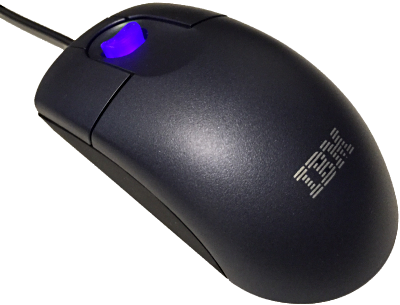
*Optical sensor IC: H2000 B0304
*Soldered-down internal mouse cable
*extra unused resistor pad (R5)
*Board model: 652000005190-1
*ScrollPoint PCB: '6'
*Mouse has slower cursor sensitivity, increased ScrollPoint sensitivity
*Mouse CAN track transparent surfaces!
'Revision B' (metallic black)
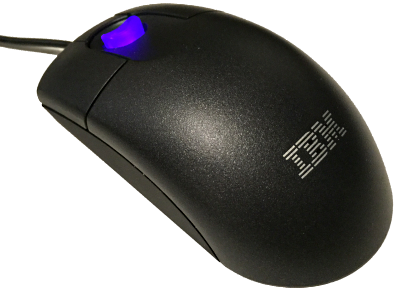
*Optical sensor IC: A2051 A0316
*Detachable internal mouse cable
*extra unused capacitor pad (C2)
*Board model: 651000006880-0
*ScrollPoint PCB: '4'
*Mouse has faster cursor sensitivity, decreased ScrollPoint sensitivity
*Mouse CANNOT track transparent surfaces
I have a few comments about the revision differences. First and foremost, it's interesting the earlier IBM mouse lacked a detachable USB cable-- and all of the sudden in the later models they implement this (which is helpful when you have to disassemble these mice en-masse). Obviously it's more expensive to include a detachable connector so... I'm not sure why IBM made these mice more expensive to manufacture as time went on (perhaps to make it easier to repair as they carried a 1 year on-site warranty; or someone internally at IBM wanted to make it easier for people to mod them-- unlikely).
The next important thing is that the Slate Blue ScrollPoints do have a slightly slower cursor (seems to be firmware-related) BUT they are able to work with transparent surfaces (glass, clear plastic, etc). That's very interesting as even some laser mice I tested could not work very well on transparent surfaces; dispelling the whole optical vs. laser myth. I'm not exactly sure what makes them slower (since they're both 800-DPI according to IBM), however I presume this is either the optical sensor or the microcontroller. More later on in the article about the microcontroller. I will at some point try swapping the ICs to determine which one is responsible for the behaviour change.
Ideally it would be nice to have the transparency tracking features of Revision A, coupled with revision A's more sensitive ScrollPoint, and revision B's faster cursor sensitivity.
The revisions are colour specific: IBM never offered both colours for both revisions-- Slate Blue colours common during the NetVista series.
It appears there have been two manufacturers for the Slate Blue plastic bezels as the colour can vary from being more blue or purple. Here's a photo comparing both slate blue colours and a metallic black:
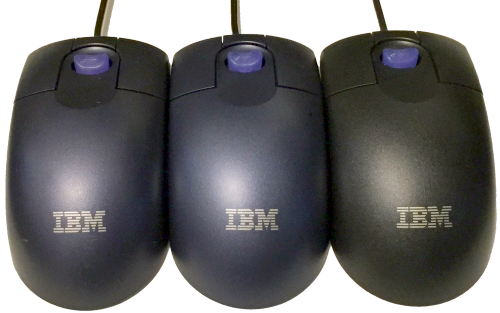
Model RO070 (ScrollPoint II Wireless)
Based on model MO09K, these ScrollPoint mice are slightly elongated to compensate for the wireless circuitry. They were paired with the earlier IBM wireless keyboard.
Model: MO18B (ScrollPoint Pro)
Part # 33L3246 Antoque Sage / Part # 33L3247 Slate Blue
This ScrollPoint Pro (can also be referred to as the revision 1 'ball' styled ScrollPoint Pros) was released in 2000 of February with the retail price of $39.95. David Hill (the industrial designer of the mouse) remarked: "The new IBM ScrollPoint Pro Mouse demonstrates design innovation and the evolution of the mouse from computer equipment to high-tech, functional art... Internet surfers using this contoured mouse will enjoy increased comfortable and pressure-sensitive scrolling in any direction."*
*quote obtained from the IBM press release of February 28, 2000.
The first foray of the IBM ScrollPoint Pro series. These mice featured an ergonomic curve while retaining sharp angles, and the third button has been moved near the thumb area. This being part of the ScrollPoint II series; they were released with a ball instead of an optical sensor. The ScrollPoint cap was black instead of 'IBM blue' like the regular MO09K. They came in two colours: Antique Sage and Slate Blue. The models for both mice are the same, however the part number varies depending on which colour you get. These are probably the harder ScrollPoint Pros to find, but also some of the least desirable due to their 400 DPI ball mechanism. The antique sage ones are prized for their unique look, however.

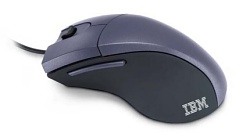
Some of the earlier ScrollPoint Pros suffer from misaligned buttons at the assembly process which results in a click response that isn't as crisp and slightly spongy. Here's a comparison between an earlier sage SP Pro with the later revision where they corrected this with an updated injection mold, you'll see how the older revision has both of the buttons veering to the right causing an uneven gap (and this isn't just the photo angle):

Fortunately you can remove the button assembly (albeit it's not easy) and correct the problem on earlier mice.
Another difference is that the bottom covers are different between the two as well:
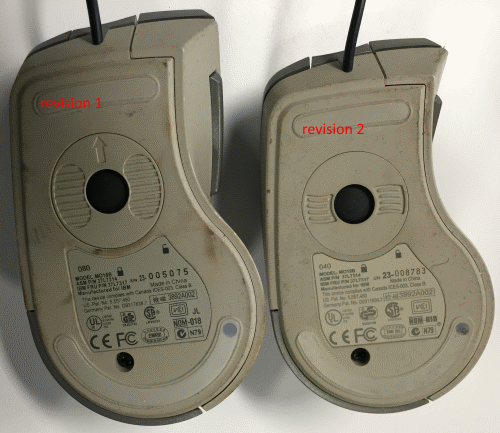
Model MO18BO (ScrollPoint Pro Optical)
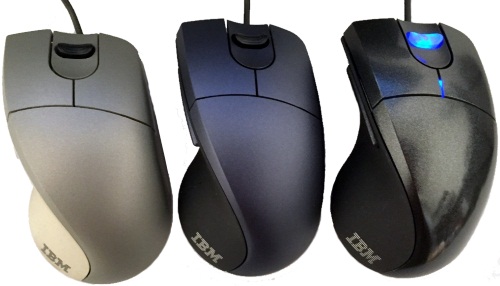
(Optical ScrollPoint Pro on the far right compared against the two ball-based Pros on the left)
The last ScrollPoint Pro to be released which came out in January of 2003 and retailed for $29.00 (on IBM's web price). These ones featured an optical sensor and a glowing ScrollPoint mechanism. The only colour they were ever released in was metallic black (but as mentioned before you can mod them to being Ancient Sage or Slate Blue). They are considerably lighter than the ScrollPoint II Pro mice lacking the heavy rubberized ball bearing. It's worth noting that the internal assembly of the ScrollPoint Pro uses a two-PCB construction, not too unlike the *original* Personal System/2 mouse. These mice are no longer manufactured as previously mentioned (to be fair, 9 years is a rather long manufacturing period for a computer peripheral).
Here is the original product page for the mouse from IBM's website in 2003:
Bring more accurate maneuvering and control to your desktop with the Optical 3-Button ScrollPoint Mouse PS/2 & USB 800 dpi sensor. The 800dpi optical sensor is more accurate and faster than before. The ScrollPoint pointing stick is ideal for both horizontal and vertical scrolling, unlike standard wheel mice. Optical technology provides precision control and has no mechanical ball, thus there is no need for a mouse pad.
Features and Benefits:
* Allows your fingers to rest easily and naturally on the mouse buttons
* No mouse pad required! Works on many types of surfaces. No mechanical ball to get dusty, dirty or stolen.
* Integrated ScrollPoint pointing device provides excellent horizontal and vertical scrolling. Includes programmable 3rd button for added functionality
* Business Black color compliments NetVista and ThinkPad systems
General
Model name: 31P8700
Description: ScrollPoint Pro 800 DPI Optical Mouse
IBM Web Price: $29.00
Architecture
Color: Metallic Black
Depth Metric: 122 mm
Depth US: 4.8 in
Height Metric: 48 mm
Height US: 1.8 in
Weight Metric: 0.14 Kg
Weight US: .30 lbs
Width Metric: 73 mm
Width US: 2.9 in
Mice/Input Devices
Pointing Device Type: IBM ScrollPoint Pro Optical Mouse
Cable Length: 1.8 Meters
Color: Metallic Black
Connector Style: PS/2 6-Pin mini-DIN/USB Combo
Number of Buttons: 3
Pointing Device Resolution: 800 DPI
Weight & dimensions
Depth: 4.8 in
Height: 1.8 in
Width: 2.9 in
Weight: .30 lbs
ScrollPoint Pro 'Special Edition'
It is possible to swap parts with the later M018BO optical ScrollPoint Pros (if you want to convert your optical ScrollPoint Pro to being a different colour, or borrow one of the rubber sides to replace your worn down one). Lenovo has not manufactured any of the M018B mice as this predates when IBM sold their Personal Systems division.
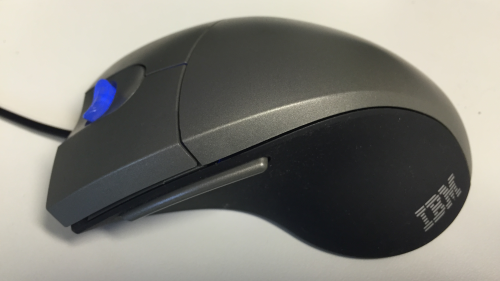
Some minor changes need to be done, either the tabs on the optical base or the older silver top need to be cut. And fortunately you can just use the black rubber siding from a slate blue MO18B so it fits nicely at the top and you get a fresh piece. And finally you'll need to cut a larger opening for the clear 'window' piece that allows blue illumination through. This part can be skipped if you don't want the glowing aspect (you could even desolder the LED). However I think it looks nice so I kept it.
Swapping parts from a ScrollPoint Pro MO18B to MO18BO
Often times the ball styled ScrollPoint Pro (MO18B) mice remain in new condition untouched over the more desired optical variants (MO18BO). It is possible to 'donate' the rubber siding from the ball ScrollPoint Pro to the optical one, this does require some minor modifications however.
#1 cutting a corner from the rev1 rubber siding the rubber siding from the rev1 requires a small amount of the corner to be cut, as it gets in the way of a post of the rev2, shown here:
#2 removing a stem from inside the rev2 metallic left click button the top metallic left click button has an extra stem which gets in the way of the rev1 rubber siding. You have to use a fine pair of pliers to snip the excess plastic out, shown here:
#3 swapping the thumb button plastics It takes a bit of careful prying, but the plastic for the thumb button can be removed and moved over into the new host so that the metallic black plastic colouring remains consistent.
Once all steps are completed you'll be able to replace the siding on the base of the Optical ScrollPoint Pro-- the colour is pretty close being only *slightly* lighter than the original (and actually the logo printing is of higher quality):
Fixing the divot on the button plastic
After in extensive use the microswitch will cut the plastic of either left or right clickable buttons (and the thumb button if you use that frequently). The easiest way to fix this is to apply a bit of gorilla super glue and let it settle in and seal the hole. After this you will need an X-ACTO knife to cut away any excess, if you do not the buttons won't align properly disallowing them to click. Be careful not to cut too deep and slice away the plastic. Make sure there is no excess glue to make the buttons taller in height than they were originally: if this happens the buttons will not depress properly and feel restricted when clicking:
Sometimes they are listed under 31P8700, I think this might be only on very early models from 2003. 90P0741 is also listed in some documentation. The ASM and FRU part numbers are different from IBM and Lenovo released models that I have seen in person:
IBM released ScrollPoint Pros:
ASM P/N: 24P0504
IBM FRU P/N: 24P0505
Lenovo released ScrollPoint Pros:
ASM P/N: 41U3020
FRU P/N: 41U3021
Anatomy of the ScrollPoint
For an anatomy analysis we'll use the standard ScrollPoint III (the general design is the same across all models--however the ScrollPoint I may be different).To disassemble a ScrollPoint (or even a standard issue wheel based IBM mouse) you must: A) remove the single screw at the bottom B) remove the ScrollPoint cap C) lift the top bezel UP and towards you facing the IBM logo.
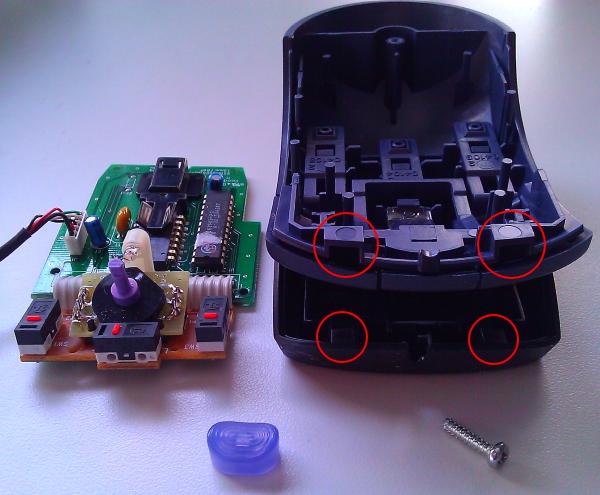
The ScrollPoint mechanism is mounted on the same PCB as the buttons and is slid on two three-pin standoffs (standard pitch between the pins). The LED is mounted facing just behind the same-- it can be swapped out for any desired colour. This PCB is connected by two ribbon cables that are hard-soldered.
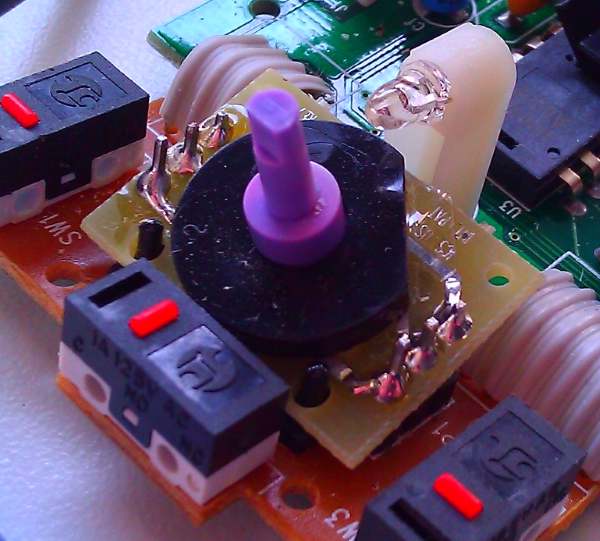
Upon removing the top bezel, the buttons are actually detachable from the bezel. If you have different coloured ScrollPoints, you can mix and match button colours.
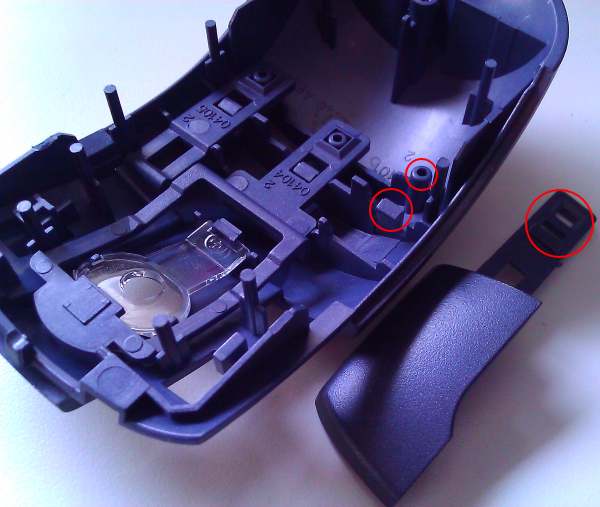
Disassembling the ScrollPoint mechanism itself reveals the pads which sense the resistance when compressed, along with the patent number for the technology on the back (which doesn't seem to be an IBM patent):
ScrollPoint LED Mods
The ScrollPoint III uses a 3mm blue LED to light up the ScrollPoint. However, the stark blue doesn't quite match the translucent "IBM blue" ScrollPoint cap (which is very close to lavender). I've replaced the original blue LED with a purple one, and it really fits the mouse very well (1) matching the ScrollPoint cap's original colour much better (2) makes the glow a lot more soft and less visually intrusive. When you're replacing the ScrollPoint LED, ensure the replacement has sufficiently long leads to go inside the spacer.
It's also possible to replace the 5mm red optical sensing LED to blue. This really gives the ScrollPoint a unique colour and helps keep with the theme a lot better. Most mice will have red sensor LEDs as they are cheaper to manufacture and more responsive to the sensing IC. In my opinion the purple / blue combo is the most aesthetic and consistent.
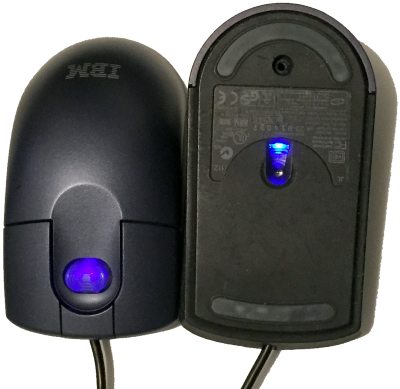
Other colours can be used as well, however not all will mix well with the IBM blue transluscent caps. Green probably looks the worst as it changes the cap to look an almost grey-like colour.
ScrollPoint Sensor Optimization
If you rely on the ScrollPoint over a conventional 'wheel' mouse and are seeking to increase the performance and capability of your ScrollPoint; there are a few modifications that can help the existing sensor used in these mice.
Laser mod
What separates an "optical" mouse from a "laser" mouse is simply the type of light emitting diode used. Optical mice use (generally) either red or blue LEDs, whereas laser mice use infrared LEDs. Therefore it may be possible to replace the existing red LED with an infrared one. I am not sure if the sensor will pick it up, but it should; and if it does, you'll have a more intuitive mouse able to hit more surface variations. Once I order some appropriate infrared 5mm LEDs to perform the test, I will update this section.
It appears the Revision A 'Slate Blue' ScrollPoint is already capable of tracking transparent surfaces.
PCB swap
If you're running a Slate Blue rev. A with 652000005190-1, swap the PCB with a metallic black rev. B 651000006880-0 for faster cursor response. You will lose the ability to track transparent surfaces however (presently looking into how to get the 'best' of both). If you're going to use a Lenovo board, be warned that some people have reported premature failure with them-- most likely due to cold solder joints or prematurely failed capacitors. Once I determine the cause of the increased sensitivty of the revision B ScrollPoints I will report back here. This PCB swap does not apply to the ScrollPoint Pro IIIs. It's worth noting all of the later ScrollPoint mice use RoHS solder.
IC replacement
Another possible yet less practical solution might be to replace the optical sensor entirely with a superior one able to operate on transparent surfaces, but it would have to match the PCB pinout. I'm not sure what existing IC is in use by the ScrollPoints (or other optical mice which use similar indiscreet sensors).
ScrollPoint Microcontrollers
The regular ScrollPoint III uses the Cypress CY7C63743-PC microcontroller.
The ScrollPoint Pro III uses the Cypress CY7C63743C-PXC microcontroller.
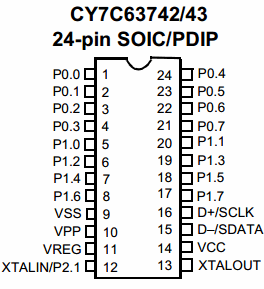
--> CY7C63743 "enCoRe I" datasheet
Both of these Cypress Semiconductor microcontrollers are designed for USB buses and also can double to be used with PS/2 by the use of a USB-to-PS/2 adapter; they're collectively known as the first enCoRe series offered by Cyprus. Because of the extra feature being able to use them with both interfaces, these microcontrollers are often found in mice from many vendors.
The firmware which controls the ScrollPoint mechanism is flashed onto these Cypress microcontrollers. It should be possible to dump the ROM and modify it to add more features and tweaking to how windows should respond to the ScrollPoint (ideally more behaved like the TrackPoint scrolling). If I ever get a chip programmer I will update this section with more information. Flashing the controller will require desoldering the Cyprus microcontroller and adding a socket; relatively easy if you have soldering equipment.
Availability
ScrollPoint mice generally go under the radar as not too many people are acute to them. Various online sellers and auctions will generally have ScrollPoint mice available in bulk. Finding ScrollPoints in new condition is more uncommon, but not impossible. Many used ScrollPoints will have little to no wear as they are generally not used in service extensively from users ultimately swapping them out for a wheel-based mouse; at least, this was common for a time when IBM bundled ScrollPoints with all of their computers (such as IntelliStations) but ended after a period due to customer disastisfaction. Like all things, eventually these mice will be harder to find as time goes on.
